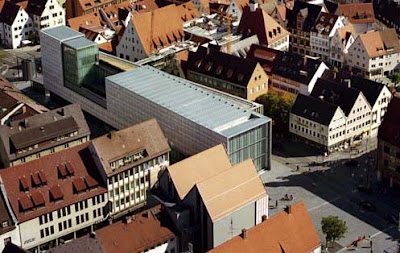Les Journaux
 Siegfried Weishaupt spent forty years collecting contemporary art, and his collection is now on public view in a new museum, the Kunsthalle Weishaupt, designed for it. Weishaupt gave the art and the money for the new building to the German city of Ulm. According to an article by David Galloway (Ulm, Germany becomes an island of art, January 1) in the International Herald Tribune, the new museum, containing 14,000 square feet of exhibition space, is connected to the existing municipal museum by a glass skywalk.
Siegfried Weishaupt spent forty years collecting contemporary art, and his collection is now on public view in a new museum, the Kunsthalle Weishaupt, designed for it. Weishaupt gave the art and the money for the new building to the German city of Ulm. According to an article by David Galloway (Ulm, Germany becomes an island of art, January 1) in the International Herald Tribune, the new museum, containing 14,000 square feet of exhibition space, is connected to the existing municipal museum by a glass skywalk.
London may soon have a new poetry center in the building that served as Rimbaud and Verlaine's love nest, according to an article by Marc Roche (La maison londonienne de Rimbaud et Verlaine, December 5) in Le Monde. The two poets lived together, for a few months in 1873, at 8, Royal College Street, just behind the new Eurostar station at Saint-Pancras in north London. Graham Henderson, director of a group called Poet in the City, wants to renovate the building as a cultural center, with exhibition space, a performance space, a library, and a cafe.
UPDATE:
Lunettes Rouges, a favorite French art blog, takes note of an interesting exhibit, Sleeping and Dreaming, at the Wellcome Collection (through March 9), also near the Saint-Pancras Eurostar station. It is a museum on medicine and science, but its exhibits often include artwork.
How much do we want a new holiday tradition in classical music? Tired of Hansel and Gretel, Messiah, and The Nutcracker? In Paris, the rejuvenated Opéra-Comique hosted a rare performance of La Boîte à Joujoux, conceived by Claude Debussy as a marionnette ballet in 1913 for his 8-year-old daughter, Chouchou. This production, performed only on December 23 and 25, turned the work into a concert tale, narrated by soprano Natalie Dessay and illustrated by projected drawings by Régis Lejonc. According to the review by Marie-Aude Roux (Natalie Dessay interprète un Debussy intime, December 25) in Le Monde, Jérôme Deschamps did not intend to host a children's concert, but the kids showed up in force. As on the recording, the music has been arranged, by Fabrice Pierre, for the six instruments of Ensemble Agora. Relating the troubled love story of a pretty porcelain doll and a lead soldier, Dessay narrates and takes on several voices of characters, all accompanied by music. DVD release, please!Available at Amazon:
Debussy, La boîte à joujoux, N. Dessay, Ensemble Agora (2005)
The London Symphony Orchestra's upcoming performance of Schoenberg's Pelléas und Mélisande at the Barbican prompted Tim Ashley to examine Maeterlinck's symbolist play and the four musical incarnations it inspired (The perfect triangle, January 4) in The Guardian. What the versions by Fauré, Sibelius, Schoenberg, and Debussy have in common is the ambiguous, disturbing story of Maeterlinck's drama, which Ashley connects in intriguing ways to the playwright's own biography.
As a follow-up to my Messiaen piece, this review of a sub-par Messiaen concert at the Bouffes du Nord in Paris by Marie-Aude Roux (L'année Messiaen débute mollement, January 10) in Le Monde cues us in to several important events for the Messiaen centenary: the Festival Messiaen au Pays de la Meije (July 10 to 20), a Parcours Messiaen involving organ concerts in and around Avignon, the Messiaen Festival in Stockholm (April 9 to 20), and From the Canyons to the Stars, the Messiaen Festival at London's Southbank Centre, under Artistic Director Pierre-Laurent Aimard.





















































No comments:
Post a Comment